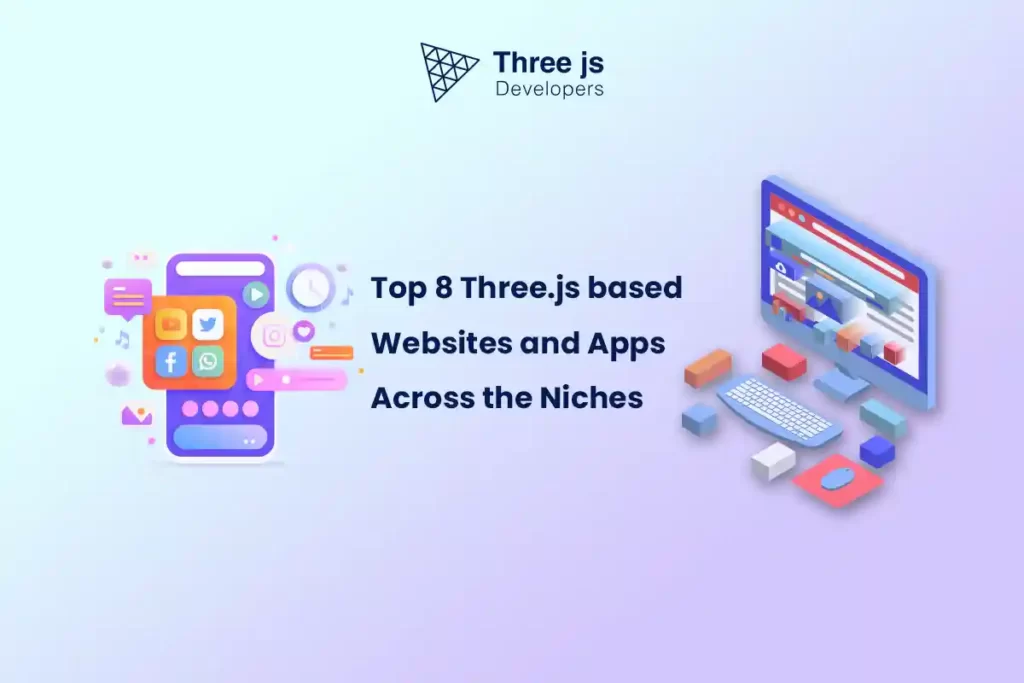Three.js, an open-source JavaScript library, bestows developers with the capacity to craft and showcase dynamic 3D computer graphics within the framework of a web browser. The underpinning technology for this feat is WebGL, a groundbreaking web standard that pioneers the introduction of 3D graphics on the web. Three.js abstracts the complexities of 3D animation and makes it accessible to developers of various skill levels.
In web development, where engaging user experiences are essential, Three.js emerges as a significant player. The capabilities of Three.js lead to the genesis of intensely immersive, interactive digital platforms – be it websites or applications – that command user attention and promote prolonged engagement. Whether bringing life to static data or turning a simple site into a virtual reality (VR) experience, Three.js is a transformative tool that broadens the horizon of web development possibilities.
Top 8 Websites/Applications Harnessing the Power of Three.js
HelloRacer
HelloRacer turbocharges web-based gaming with Three.js, offering users an immersive 3D racing experience. The application fires on all cylinders, with intricately detailed car models and hyper-realistic environments rendered in real time. The smooth performance and stunning visuals emphasize the power and potential of Three.js in the realm of web-based applications. This showcase is not only a nod to the future of online gaming but also a testament to the remarkable capabilities of Three.js, an engine driving the creation of visually captivating and interactive experiences on the web. Experience the race here: HelloRacer.
HelloRacer Features:
The application showcases detailed and accurate car models coupled with realistic lighting and shadows that adapt to the car’s movement. It also includes a user-controlled camera system, providing an immersive first-person perspective.
Advantages of using Three.js:
Three.js allows HelloRacer to create a captivating, real-time 3D experience within the web browser without any plugins. Its efficient rendering capabilities contribute to the smooth and responsive user experience central to this application.
Particle Love
Particle Love is an amalgamation of artistry and technology, utilizing the dynamic capabilities of Three.js to create a fluid, interactive particle simulation. It is a captivating dance of countless particles, each moving in unison, generating mesmerizing patterns and formations. The real-time interactivity, a testament to Three.js, invites users into a unique relationship with the digital universe, empowering them to manipulate the choreography of particles. The fusion of aesthetics and performance embodied by Particle Love showcases how Three.js has redefined the frontiers of web design, transforming static webpages into vibrant, interactive digital canvases. Experience it here Particle Love.
Particle Love Features:
The website allows users to interact with mesmerizing particle systems that react to mouse movements. It also features music synchronization, with particles reacting to the beat of the background music.
Advantages of using Three.js:
Three.js’s powerful rendering capabilities enable Particle Love to handle thousands of particles at once, providing a smooth, seamless experience. Thanks to Three.js, traditional web technologies are taken up a notch, facilitating the creation of dynamic and visually compelling experiences that transform the concept of user interactivity.
BioDigital Human
BioDigital Human is an awe-inspiring embodiment of Three.js technology. This avant-garde 3D platform is dedicated to exploring human anatomy, diseases, and treatments. With Three.js at its core, BioDigital Human showcases an intricately detailed and interactive 3D human body model, offering an immersive journey through the body’s complex systems. This technology-enhanced exploration amplifies the understanding of medical science for both learners and educators. Experience the exploration here: BioDigital Human.
BioDigital Human Features:
BioDigital Human is a treasure trove of features that enhance its educational prowess. The platform offers comprehensive, interactive 3D views of various body systems like the skeletal, muscular, and circulatory systems. Every model is interactive, with components that reveal more information when clicked. Moreover, users can manipulate the view, zoom in and out, rotate, and strip layers to uncover the fascinating complexities of human anatomy.
Advantages of using Three.js:
Three.js’s role in BioDigital Human is pivotal. It enables the creation of a comprehensive, interactive 3D human body model that substantially amplifies the platform’s educational efficacy. Complex anatomical structures are rendered accessible and engaging thanks to the user-friendly design enabled by Three.js. The high level of interactivity, precision, and user control facilitated by Three.js is a testament to the library’s potential to transform educational content, making learning effective and enjoyable.
Rome: WebGL Experiment
Rome: WebGL Experiment is an avant-garde initiative that fuses music and interactive cinema into a compelling web experience using Three.js. This interactive music video launches users into an extraordinary, ever-changing landscape that moves rhythmically with the music. User interactivity within this surreal environment amplifies the versatility of Three.js, converting mere spectators into engaged participants in this multimedia marvel. This venture highlights Three.js’s ability to interconnect diverse digital media forms, promoting creation of deeply immersive and multi-faceted web experiences. Experience it here: Rome: WebGL Experiment.
Rome Features:
The application allows users to navigate through a 3D landscape, interacting with different elements that trigger animations and sounds. It also provides an exploratory experience of the song “3 Dreams of Black” by Danger Mouse and Daniele Luppi.
Advantages of using Three.js:
Three.js facilitates the creation of this complex, immersive multimedia experience, showcasing its capability to handle detailed 3D models, animations, and sound synchronization. Three.js illustrates how web technologies can create a new interactive and participatory storytelling genre.
Clouds over Cuba
Clouds over Cuba is an immersive documentary that revives the historical narrative of the Cuban Missile Crisis using Three.js. By incorporating a blend of historical archives and 3D interactive elements, it delivers an unprecedented educational experience. Users can traverse a detailed event timeline, delve into prominent political figures, and envisage potential alternative outcomes, constructing an extensive perspective of the crisis. Three.js facilitates the seamless integration of various multimedia elements, testifying its profound capacity in historical education and digital narratives. Experience history here: Clouds over Cuba.
Clouds Over Cuba Features:
The application provides a historical narrative augmented with 3D visualizations of archival footage and photos. It also has an interactive timeline for users to explore key events.
Advantages of using Three.js:
With Three.js, Clouds over Cuba offers an engaging, immersive educational experience. It sheds light on the versatility of Three.js, exemplifying its capability to manage various media formats and construct an engaging, interactive learning space that serves as a temporal bridge between historical events and present exploration.
Spacetime
Spacetime is a groundbreaking educational platform that leverages Three.js to illustrate the complex concept of Spacetime – a crucial element of Einstein’s Theory of Relativity. Through its interactive 3D models and simulations, Spacetime helps users intuitively understand and explore this abstract theory. Three.js’s power to visualize these scientific concepts has made learning more accessible and engaging. Embark on the cosmic journey here: Spacetime.
SpaceTime Features:
Spacetime stands out for its effective use of Three.js in creating an educational tool. The platform offers interactive animations demonstrating how mass distorts Spacetime, leading to phenomena like gravity. These visualizations, enabled by Three.js, make exploring scientific theories more immersive and understandable.
Advantages of using Three.js:
The use of Three.js in Spacetime presents numerous advantages. It facilitates the visual representation of abstract concepts, making them more understandable and engaging. By transforming passive learning into an interactive experience, Three.js enhances user engagement and learning outcomes. This innovative approach to education, enabled by Three.js, emphasizes the enormous potential of this technology in educational technology.
Make Me Pulse
Make Me Pulse is a digital greetings platform that utilizes Three.js to create memorable and engaging interactive experiences. Each greeting card on the platform is a lively composition of colors, shapes, and movements, aiming to captivate users emotionally and visually. The detailed animations and interactive features enabled by Three.js invite users to participate in their digital journey rather than observe actively. By seamlessly combining visual appeal and interactivity, Make Me Pulse showcases how Three.js can enhance digital creativity, forging experiences that deeply connect with users. Discover the visual magic here: Make Me Pulse.
Make Me Pulse Features:
Each greeting card features an interactive 3D scene that reacts to user input and mouse movements. The website also includes a soundtrack that synchronizes with the visuals.
Advantages of using Three.js:
Three.js allows Make Me Pulse to create mesmerizing, real-time interactive visual experiences. This brings a new level of engagement to digital greetings, illustrating the transformative potential of Three.js in web design.
The Boat
Description: Taking storytelling to the next dimension, The Boat is a groundbreaking digital creation that employs the capabilities of Three.js to redefine the boundaries of an interactive graphic novel. It narrates a gripping tale of escape post the Vietnam War, inspired by Nam Le’s short story from “The Boat.” Thanks to Three.js, the narrative gets a new lease of life, skillfully blending visuals, text, and audio to engross users in an immersive narrative experience. This novel storytelling approach fosters deeper empathy toward the human struggles etched in the annals of history. Explore the narrative here: The Boat.
The Boat Features:
The Boat’s magic lies in its harmonious blending of literature and technology. The website’s design, powered by Three.js, crafts a vivid, immersive environment that amplifies the impact of the text. With the dynamism of graphics and textual elements that change based on user interaction, readers find themselves entwined in the story, making it a more engaging experience. The narrative is further enriched by audio clips, immersing readers in an emotional soundscape that complements the story.
Advantages of using Three.js:
Three.js’s integration in The Boat ushers in manifold benefits. At the forefront is the enhanced user engagement it enables through interactive 3D elements. These elements submerge the reader in the narrative, deepening the emotional connection to the story. Moreover, the flexibility offered by Three.js allows for intuitive control of the narrative pace driven by user interaction. Thus, every reader’s journey becomes uniquely personal. Moreover, the richer visual storytelling made possible by Three.js enables capturing of subtle nuances and emotional depth, offering an engaging user experience surpassing traditional digital storytelling.
Conclusion
These websites and applications represent just a fraction of the potential applications of Three.js. As we move further into the era of interactive and immersive web experiences, Three.js will undoubtedly continue to play a vital role. In crafting visually arresting imagery, devising interactive user interfaces, or rendering complex data in an understandable format, Three.js stands out as an instrumental ally, relentlessly pushing the envelope in web development possibilities.



